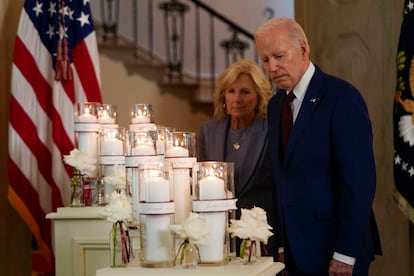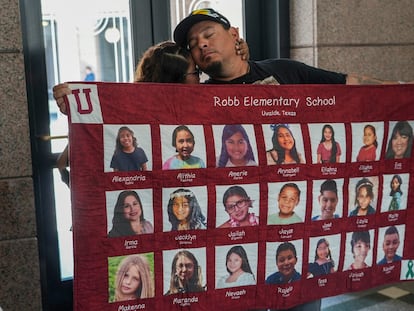On first anniversary of Uvalde school shooting, Biden says ‘it’s time to act’ on gun control
The president said from a solemn White House memorial that too many schools, too many everyday places have become ‘killing fields’

As families and loved ones mourn the unimaginable loss of 19 children and two teachers shot dead last year in Uvalde, Texas, President Joe Biden said from a solemn White House memorial that too many schools, too many everyday places have become “killing fields.”
The town planned a private ceremony and candlelight vigil in the evening, and the Texas legislature paused for a few moments of silence at 11:30 a.m. CDT, the moment the shooter entered Robb Elementary School last year, touching off the nation’s deadliest school shooting in a decade.
Biden delivered remarks in front of a display with 21 candles, one for each victim, with a white rose and satin ribbons in school colors that displayed each victim’s name and age. All the students killed were between the ages of 9 and 11 years old. Before the president spoke, he and first lady Jill Biden, who is a teacher, stopped to look at the names of the dead.
“I realize this is a very tough day for all the families,” Biden said quietly. “Remembering is important, but it’s also painful.”
Biden spoke of how he stood in Uvalde a few days later, staring at 21 crosses outside the school with the names of victims. He said they spent hours with the grieving families.
“We know one year later, this is still so raw for you,” he said. “You’ll miss birthdays and holidays, school plays, soccer games. Just that smile. A year of everyday joy, just gone forever.”
The killings, along with another mass shooting in Buffalo, New York, prompted bipartisan legislation that passed through a divided Congress just a month later. It was the most significant gun safety law in decades.
The law toughened background checks for the youngest gun buyers, and sought to keep firearms from domestic violence offenders and to help states put in place red flag laws that make it easier for authorities to take weapons away from people adjudged to be dangerous.
“Too many schools, too many everyday places have become killing fields in communities across America. And in each place, we hear the same message: Do something. For God’s sake, just do something,” Biden said. “We did something afterwards, but not nearly enough.”
Those laws haven’t stopped mass shootings or gun deaths of children. And Uvalde is still managing the fallout from the botched emergency response to the shooting. An investigation is still ongoing into how the days after the attack were marred by authorities giving inaccurate and conflicting accounts about efforts made to stop a teenage gunman armed with an AR-style rifle. It was the worst shooting in a school since 2012, when 20 children between 6 and 7 years old and six adults were murdered at Sandy Hook Elementary School in Newtown, Connecticut.
A damning report by Texas lawmakers found nearly 400 officers had been on the scene, from an array of federal, state and local agencies. The findings laid out how heavily armed officers waited more than an hour to confront and kill the 18-year-old gunman. It also accused police of failing “to prioritize saving innocent lives over their own safety.”
In Austin, Texas, on Wednesday, a bipartisan group of lawmakers led by state Sen. Roland Gutierrez, a Democrat who represents Uvalde, read the names of the 21 victims who were murdered as the entire chamber paused in remembrance.
Each victim was memorialized with a speech, describing who they were and the loved ones they left behind. “I pray that in all of our differences, we aspire to our better angels, perhaps remember those moments when we were little,” Gutierrez said. “Look at the pictures of these children and remember our better angels.”
Throughout Texas’ biennial legislative session, which began in January and ends Monday, a group of the victims’ family members made the three-hour drive to Austin every Tuesday, with few exceptions, to lobby lawmakers in hopes of raising the legal age requirement to own certain semiautomatic weapons — like the one used by the 18-year-old Uvalde shooter — from 18 to 21.
But in the GOP-controlled Texas Capitol, Republicans this year rejected it and nearly all other proposals to tighten gun laws.
Several months in, the new federal law has had some success: Stepped-up FBI background checks have blocked gun sales for 119 buyers under the age of 21, prosecutions have increased for unlicensed gun sellers and new gun trafficking penalties have been charged in at least 30 cases around the country. Millions of new dollars have flowed into mental health services for children and schools.
Yet since that bill signing last summer, the tally of mass shootings in the United States has only grown. Five dead at a nightclub in Colorado. Eleven killed at a dance hall in California. Three 9-year-olds and three adults shot and killed at an elementary school in Nashville, Tennessee. Seven shot dead in rural Oklahoma.
As of May 24, there have been at least 25 mass killing incidents in the U.S. so far in 2023, leaving at least 127 people dead, not including perpetrators who died, according to a database maintained by The Associated Press and USA Today in partnership with Northeastern University.
That puts the country on a faster pace for mass killing incidents than in any other year since 2006, according to the database, which defines a mass killing as an incident in which four or more people are killed, not including the perpetrator, within a 24-hour period.
There have been at least 556 incidents in all since 2006 in the U.S., according to the database, leaving at least 2,892 people dead.
Firearms are the No. 1 killer of children in the U.S. and so far this year, 85 children younger than 11 have died by guns and 491 have died between the ages of 12 and 17. As of 2020, the firearm mortality rate for children under 19 is 5.6 per 100,000. The next comparable is Canada, with .08 per 100,000 deaths.
“It’s time to act,” Biden said. “It’s time to make our voices heard. Not as Democrats or Republicans. But as friends, as neighbors, as parents — as fellow Americans.”
“I know for a long time it’s been hard to make progress,” Biden said. “But there will come a point where our voices are so loud, our determination so clear, that it can no longer be stopped. We will act.”
Sign up for our weekly newsletter to get more English-language news coverage from EL PAÍS USA Edition
Tu suscripción se está usando en otro dispositivo
¿Quieres añadir otro usuario a tu suscripción?
Si continúas leyendo en este dispositivo, no se podrá leer en el otro.
FlechaTu suscripción se está usando en otro dispositivo y solo puedes acceder a EL PAÍS desde un dispositivo a la vez.
Si quieres compartir tu cuenta, cambia tu suscripción a la modalidad Premium, así podrás añadir otro usuario. Cada uno accederá con su propia cuenta de email, lo que os permitirá personalizar vuestra experiencia en EL PAÍS.
¿Tienes una suscripción de empresa? Accede aquí para contratar más cuentas.
En el caso de no saber quién está usando tu cuenta, te recomendamos cambiar tu contraseña aquí.
Si decides continuar compartiendo tu cuenta, este mensaje se mostrará en tu dispositivo y en el de la otra persona que está usando tu cuenta de forma indefinida, afectando a tu experiencia de lectura. Puedes consultar aquí los términos y condiciones de la suscripción digital.
More information
Archived In
Últimas noticias
David Bowie, the galactic thinker who encouraged us to break new ground
John Berger and the loss of rural culture
From police officer to bloodthirsty kidnapper: Terror in Mexico during the years of ‘The Ear Chopper’
Alain Aspect, Nobel laureate in physics: ‘Einstein was so smart that he would have had to recognize quantum entanglement’
Most viewed
- David King, chemist: ‘There are scientists studying how to cool the planet; nobody should stop these experiments from happening’
- Reinhard Genzel, Nobel laureate in physics: ‘One-minute videos will never give you the truth’
- Oona Chaplin: ‘I told James Cameron that I was living in a treehouse and starting a permaculture project with a friend’
- Sinaloa Cartel war is taking its toll on Los Chapitos
- Mexico completes its trade shift with the entry into force of tariffs on China and countries without trade agreements










































